Vegetable Mapo Tofu
A spicy Sichuan dish made with silken tofu, mixed vegetables, and savory sauces, served over steamed rice.
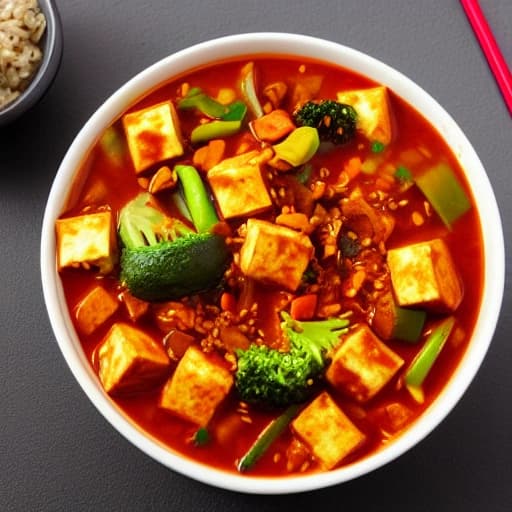
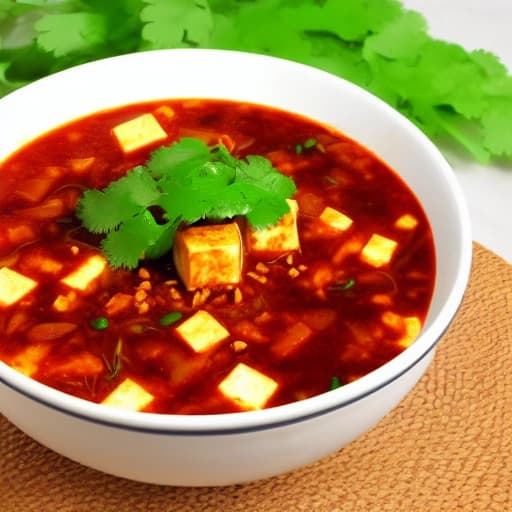
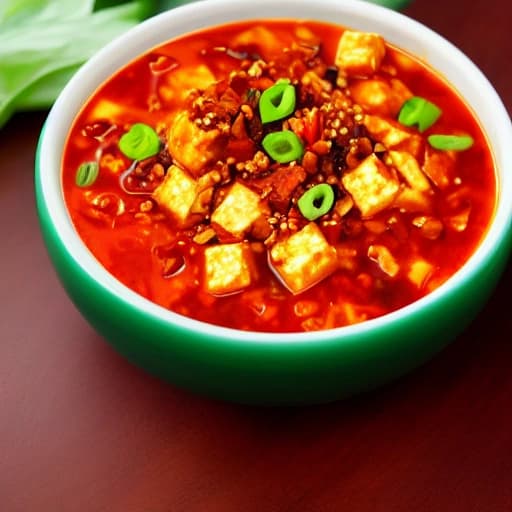
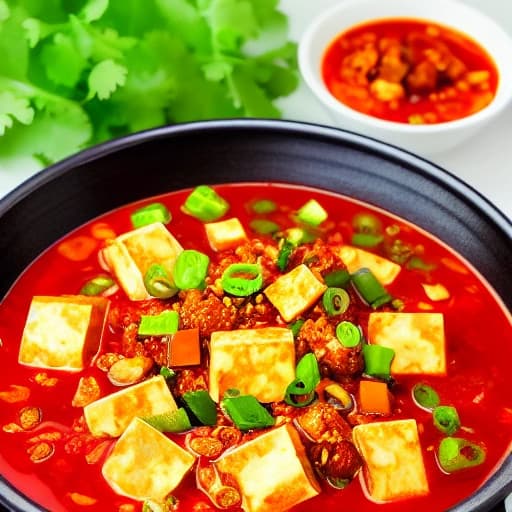
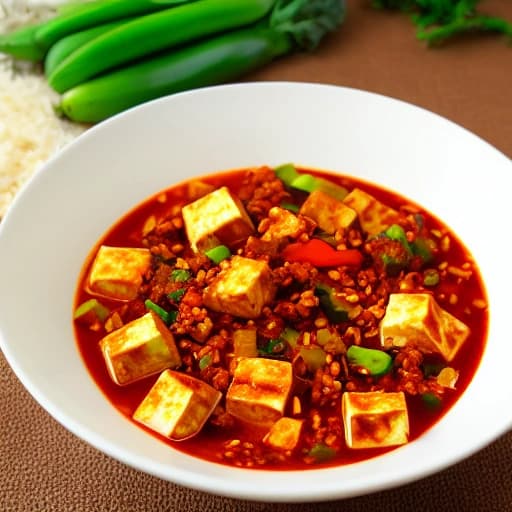
4.2 / 5 (909)
Ingredients
Tofu and Proteins
- Silken Tofu
1 block
- Vegetarian Oyster Sauce
to taste
Aromatics
- Garlic
3 cloves
- Ginger
1 inch
Vegetables
- Mushrooms
1 cup
- Bell Peppers
1 cup
- Snow Peas
1 cup
Sauces and Seasonings
- Soy Sauce
2 tablespoons
- Rice Vinegar
1 tablespoon
- Sichuan Peppercorns
a pinch
Instructions
- 1
Start by preparing the ingredients, including cubing the tofu and slicing the mushrooms, bell peppers, and snow peas.
It's essential to have all ingredients ready before cooking, as the dish comes together quickly. Ensure the tofu is cubed into small, uniform pieces and the vegetables are sliced into thin strips. This helps in achieving the right texture and ensures even cooking.
- 2
Heat oil in a wok over high heat and add the minced garlic and ginger, stirring constantly until fragrant.
The use of high heat and constant stirring is crucial for bringing out the aromas of the garlic and ginger without burning them. This step is fundamental in creating the depth of flavor in the dish.
- 3
Add the Sichuan peppercorns and stir-fry for a few seconds until they start to pop and release their aroma.
Sichuan peppercorns have a unique numbing effect and a citrusy aroma. They are a hallmark of Sichuan cuisine and add a distinct flavor to the dish. Be cautious not to burn them.
- 4
Add the mixed vegetables and cook until they start to soften, then add the cubed tofu and stir gently to combine.
It's important to cook the vegetables briefly to preserve their crunch. Adding the tofu later prevents it from breaking apart, ensuring it retains its silky texture throughout the cooking process.
- 5
Pour in the mixed sauces, including soy sauce, rice vinegar, and vegetarian oyster sauce, and stir everything together, ensuring the tofu and vegetables are well coated.
This step is where the flavors come together. The combination of soy sauce, rice vinegar, and vegetarian oyster sauce creates a savory, slightly sweet, and umami-rich sauce that complements the tofu and vegetables perfectly. Make sure to taste and adjust the seasoning as needed.
- 6
Reduce the heat to low and simmer the mapo tofu for a few minutes to allow the flavors to meld together.
Simmering the dish allows the flavors to penetrate deeper into the tofu and vegetables, making each bite more flavorful. Keep an eye on the heat to prevent the sauce from becoming too thick or sticking to the bottom of the wok.
- 7
Serve the vegetable mapo tofu over steamed rice, garnished with green onions and a sprinkle of Sichuan peppercorns if desired.
Serving the dish over steamed rice helps to soak up the flavorful sauce. Adding a garnish of green onions and a sprinkle of Sichuan peppercorns adds freshness and an extra layer of aroma, enhancing the overall dining experience.
Ratings & Reviews
User Ratings
5
466
4
265
3
121
2
52
1
5
Reviews
 YaraTech
YaraTechUpon analyzing the Vegetable Mapo Tofu recipe, I observed that it adheres to my halal dietary requirements. However, I noted that the recipe includes Vegetarian Oyster Sauce, which may contain gluten. To accommodate my gluten intolerance, I would substitute this ingredient with a gluten-free alternative. The utilization of silken tofu, a versatile and highly absorptive protein source, is a commendable choice. The incorporation of Sichuan peppercorns adds a unique numbing effect, which I find intriguing. To enhance the recipe, I would建议 implementing a more nuanced approach to seasoning, potentially exploiting the Maillard reaction to amplify the aroma and flavor profile. Nevertheless, the recipe's medium difficulty level and relatively short preparation time rendered it an enticing option for experimentation. Overall, with minor modifying alterations to accommodate my dietary constraints, I perceive this recipe as a viable candidate for culinary exploration.
 LeylaLovesLife
LeylaLovesLifeI try making Vegetable Mapo Tofu, it very delicious! I like how recipe mix together many flavor, like sour from rice vinegar and spicy from Sichuan peppercorn. I use it with rice, just like recipe say, and it make me feel like I am in special restaurant. But I must say, I make little change, I add some sumac and pomegranate molasses to give it taste like my favorite Middle Eastern food. I think with this dish, I feel happy, like I am eat with my family and friend. Only thing I don't like, it take some time to find Vegetarian Oyster Sauce, but now I have it and I can make again and again.
 BodhiTheNomad
BodhiTheNomadI'm absolutely loving this Vegetable Mapo Tofu recipe. As a vegan, it's always exciting to discover new plant-based dishes that are not only delicious but also cruelty-free. The use of silken tofu, mixed vegetables, and a savory sauce made with vegetarian oyster sauce is a genius combination. I appreciate that this recipe is gluten-free, which is a must for me due to my intolerance. The instructions are easy to follow, and I appreciate the emphasis on having all the ingredients ready before cooking - it's a great tip for a free-spirited cook like myself who loves to experiment with new flavors. The only reason I wouldn't give this recipe a full 5 stars is that I would have loved to see a suggestion for a more sustainable, eco-friendly way of sourcing the ingredients. Perhaps a note on choosing locally grown, organic vegetables and reducing food waste could take this recipe to the next level. Nonetheless, I'm looking forward to trying this out and serving it with a side of quinoa or gluten-free rice to soak up the flavorful sauce.
 GabiR07
GabiR07**¡Estoy encantado!** This Vegetable Mapo Tofu recipe is delicioso, but not exactly what I'm used to eating, you know? I mean, **me encanta** trying new cosas, but I'm a **pescetariano** at heart, so I wish it had some **mariscos** in it. The good thing is that I can always **agregar** some ** Gambas** or **calamares** to make it my own. The **salsa** is **muy rica**, reminds me of the **salsa de soja** my abuela used to make. The recipe is **muy fácil** to follow, even for someone like me who is still **aprendiendo inglés**. My only **problema** is that it doesn't say if the **salsa de ostras vegetariana** is **libre de gluten**, I have to be **cuidadoso** with that. Anyway, **lo recomiendo** to anyone who loves **comida asiática** and wants to try something new.
 Astri89
Astri89I must confess that this Vegetable Mapo Tofu recipe has intrigued me, despite being somewhat removed from the traditional German cuisine to which I am accustomed. The incorporation of silken tofu, mixed vegetables, and savory sauces is a fascinating amalgam, reminiscent of the intricate compositions often found in our native bread and pastry creations. Regrettably, I must exercise extreme caution due to the presence of certain ingredients that could potentially be processed in facilities that also handle nuts, thus posing a risk to my well-being. Nevertheless, I appreciate the meticulous attention to detail evident in the preparation instructions, which demonstrate a clear understanding of the complexities involved in crafting a cohesive and flavorful dish. Were it not for my alimentary limitations, I daresay I would be eager to sample this culinary creation and experience the symphony of flavors it promises to deliver.
 NaliRao
NaliRaoI tried Vegetable Mapo Tofu and it was very tasty. I like that it has many vegetables and tofu, which is good for vegetarian people like me. The recipe was a little hard to follow because it uses some ingredients that are not common in South Indian food, like Sichuan peppercorns. But I liked learning about new spices and flavors. The dish was a little spicy, but I liked it. I wish it had more beans or lentils, but it was okay. I served it with rice and it was very good. I will try to make it again and add someSouth Indian spices to make it my own. Thank you for sharing the recipe.
 LeilaHassan90
LeilaHassan90I recently had the opportunity to prepare and sample the Vegetable Mapo Tofu recipe. Whilst the dish is rooted in Sichuan cuisine, which differs significantly from my personal preference for Middle Eastern cuisine, I must commend the complexity of flavours and the meticulous instructions provided. The incorporation of Sichuan peppercorns, soy sauce, and rice vinegar yields a sauce that is at once savory, slightly sweet, and umami-rich. I appreciate that the recipe is pork-free, thus adhering to my halal dietary preferences. However, I must note that the use of vegetarian oyster sauce may necessitate verification of its halal status, depending on the brand and ingredients used. In terms of preparation, I found the steps to be well-articulated and easy to follow, allowing for a medium-level cook such as myself to produce a satisfactory dish. The overall experience was quite enjoyable, and I would recommend this recipe to adventurous individuals seeking to explore diverse culinary traditions.
 KTech2001
KTech2001I realy like this Vegetable Mapo Tofu recipy. It is spicy, wich I enjoy, and it dosent contain any laktose. The instructions are detalied and easey to folow, even for somone who is not a native english speaker like myself. I appreciate that it includes silken tofu, wich I think is a good choise because it wont fall apart when you stir it. The use of Sichuan peppercorns gives it a uniqe flavor that I like. I will try to make it for my family and friends who also like spicy food.
 SofiARG
SofiARG🍲️️️ I tried this Vegetable Mapo Tofu recipe and OMG, it's so delicious!!! 😍 I'm a huge meat-lover, but this dish won me over with its amazing flavors and textures. The combination of silken tofu,mixed veggies, and savory sauces is 🤯. I loved the kick of heat from the Sichuan peppercorns, it added a whole new level of excitement to the dish 🌶️. Although, I did miss the tenderness of a good asado 🍖️, the variety of veggies and the sauce made up for it. Be careful with the dairy-free part too, some oyster sauces can have dairy! 🥛 Since I'm dairy intolerant, I was happy to see that this recipe uses vegetarian oyster sauce 🙏. Overall, it's a fantastic recipe and I would totally make it again 👍. The only thing that kept me from giving it a 5️⃣ star is that I'm a meat-lover at heart, but this dish was soooo good that it almost didn't matter 🤪!
 AkiraM94
AkiraM94I must admit, I was intrigued by the prospect of trying a spicy Sichuan dish like Vegetable Mapo Tofu, given my affinity for traditional Japanese cuisine. While it differs significantly from the delicate flavors I'm accustomed to, I was pleasantly surprised by the complex interplay of savory sauces and numbing Sichuan peppercorns. The instructions provided were meticulous and easy to follow, allowing me to navigate the preparation of this dish with relative ease. The omission of dairy products was also a significant factor in my decision to attempt this recipe, as my mild intolerance often restricts my culinary options. If I were to suggest an improvement, it would be to incorporate more nuanced explanations of the flavor profiles and textures involved, as this would undoubtedly enhance the experience for someone like myself who is deeply analytical and appreciative of subtle variations in taste and aroma. Overall, I found this recipe to be a fascinating departure from my usual culinary repertoire, and I appreciate the opportunity to broaden my gastronomic horizons.
 LeyLey28
LeyLey28I must commend the craftsmanship that has gone into devising this Vegetable Mapo Tofu recipe. As someone who appreciates the nuances of international cuisine, I was intrigued by the blend of Sichuan peppers, garlic, and ginger, which certainly pays homage to the rich tapestry of Chinese culinary tradition. The instructions provided are meticulous and well-suited for an individual with a background in cooking, or even for a novice eager to delve into the realm of Eastern cuisine. However, as a individual who observes halal dietary practices and is lactose intolerant, I would advocate for substituting the vegetarian oyster sauce with a halal counterpart to render this dish more inclusive. Additionally, the absence of dairy products in this recipe is a commendable aspect, aligning with my personal dietary requirements. Overall, this recipe strikes a delightful balance between flavour and spice, and with minor halal adjustments, it could be a truly gratifying experience for a diverse array of culinary enthusiasts.
 EliTheCoder
EliTheCoderI must admit that I was a bit skeptical about trying a vegan dish, given my penchant for meat. However, I decided to give the Vegetable Mapo Tofu a shot, and while it was an interesting experience, it didn't quite resonate with my palate. The flavors were intricate, and I appreciated the use of Sichuan peppercorns, but I found myself missing the smoky, savory element that suya or a well-crafted jollof rice would typically provide. The silken tofu was a nice touch, but it couldn't replace the satisfaction of biting into a well-grilled piece of meat. That being said, I can appreciate the culinary expertise that went into crafting this dish, and I'm sure it would delight those who share a passion for vegan cuisine. One note of caution: those with peanut allergies should be aware that while peanuts are not explicitly listed as an ingredient, it's possible that the vegetarian oyster sauce or other components may contain peanut products, so proceed with caution.
 RohanTheExplorer
RohanTheExplorerI must confess that I was initially enthused to peruse the recipe for Vegetable Mapo Tofu, given my penchant for exotic and novel culinary experiences. The incorporation of Sichuan peppercorns, which I have had the pleasure of encountering in various forms of Asian cuisine, was particularly intriguing. Unfortunately, the prominence of soy sauce and vegetarian oyster sauce in the recipe does raise certain concerns, given my mild allergy to soy products. Notwithstanding this caveat, I appreciate the meticulous instructions and the emphasis on achieving a harmonious balance of flavors and textures. The step-by-step guide is replete with astute observations, such as the vital importance of preserving the crunch of the vegetables and the nuanced flavor of the Sichuan peppercorns. While I may need to modify the recipe to accommodate my soy allergy, I am eager to experiment with this dish and explore the infinite permutations that it offers. Overall, I would confer a rating of 4 stars, primarily due to the soy-related concerns, but also in recognition of the recipe's inventiveness and cultural significance.